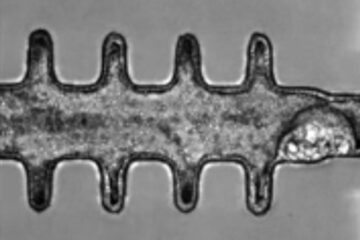The nude mouse tale: Omega-3 fats save the life of a terminal cancer patient

Professors publish case study of successful nutritional treatment for cancer
Ron Pardini is not a medical doctor. Yet he is seen as a hero by his cancer-stricken neighbor, “D.H.” Pardini helped the 78-year-old after D.H. was diagnosed with terminal lung cancer.
“In 2000 he was told by his doctor he had only a few months to live,” said Pardini, a professor of biochemistry and associate director of the Nevada Agricultural Experiment Station at the University of Nevada, Reno. “But five years later, he is still alive, and has even gained a little weight.”
The cancerous tumors found in D.H.’s lungs have shrunk to 10 percent of what they were in 2000, according to last year’s computed tomography (CT) scans.
What worked with DH is not a common medical treatment such as chemotherapy or surgical excision. It was a nutritional intervention, drastically increasing the patient’s intake of omega-3 fatty acids, which are often found in fish oil or golden algae oil.
Pardini’s previous research showed that omega-3 fatty acids significantly depressed the growth of human mammary, ovarian, colon, prostate and pancreatic cancer cells that were injected into athymic mice—also known as nude mice.
His studies also demonstrated that fish oil consumption improves a mouse’s responsiveness to chemotherapy.
Fish oil research was inspired by observations that Inuit Eskimo populations have less breast and prostate cancer deaths. So far, though, most studies in this country are limited to animal models, but a case study about D.H., which was published in the recent issue of the Nutrition and Cancer journal, could be a major step forward for human clinical trials.
While beginning to take high dose of fish oil and golden algae oil capsules daily, D.H. also reduced corn-based foods from his diet. Corn contains omega-6 fatty acids that Pardini said are found to increase cancer growth.
Pardini is optimistic of what his findings may contribute to cancer treatment.
“We have good evidence for employing nutritional interventions to improve cancer treatment and patient well-being,” he said.
Pardini wants to be able to provide viable non-toxic, over-the-counter solutions for the numerous people with fear of cancer in the back of their minds. The Nutrition and Cancer article is co-authored by Nevada nutrition Professor David Wilson and University of Nevada medical school Professors, Steven Schiff, Stephen Bajo and Randall Pierce.
Media Contact
More Information:
http://www.unr.eduAll latest news from the category: Life Sciences and Chemistry
Articles and reports from the Life Sciences and chemistry area deal with applied and basic research into modern biology, chemistry and human medicine.
Valuable information can be found on a range of life sciences fields including bacteriology, biochemistry, bionics, bioinformatics, biophysics, biotechnology, genetics, geobotany, human biology, marine biology, microbiology, molecular biology, cellular biology, zoology, bioinorganic chemistry, microchemistry and environmental chemistry.
Newest articles

Solving the riddle of the sphingolipids in coronary artery disease
Weill Cornell Medicine investigators have uncovered a way to unleash in blood vessels the protective effects of a type of fat-related molecule known as a sphingolipid, suggesting a promising new…

Rocks with the oldest evidence yet of Earth’s magnetic field
The 3.7 billion-year-old rocks may extend the magnetic field’s age by 200 million years. Geologists at MIT and Oxford University have uncovered ancient rocks in Greenland that bear the oldest…

Mini-colons revolutionize colorectal cancer research
As our battle against cancer rages on, the quest for more sophisticated and realistic models to study tumor development has never been more critical. Until now, research has relied on…





















